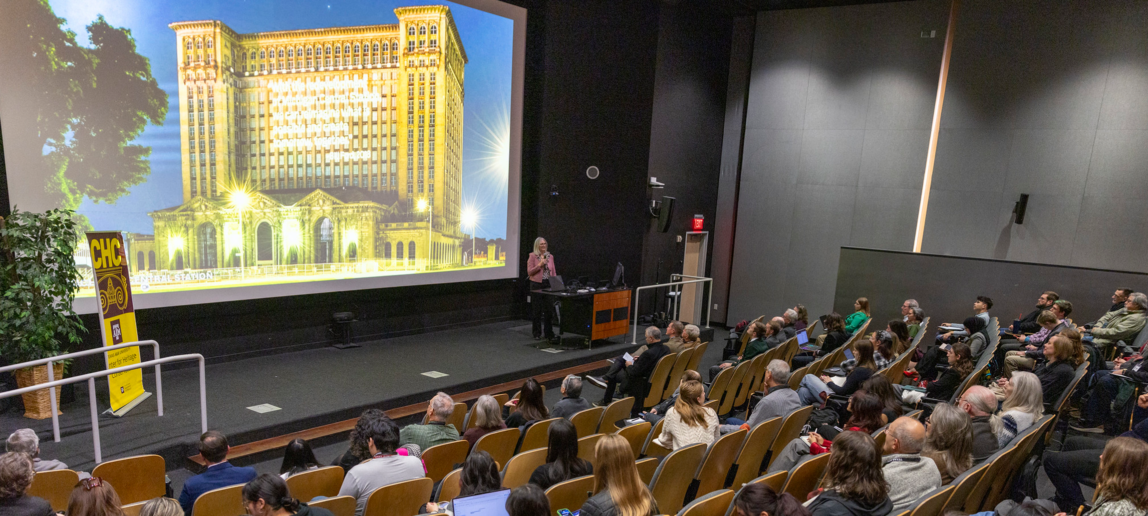Future-Proof: 26th Annual CHC Symposium pursues preservation in a fast moving world
The Center for Heritage Conservation (CHC) at the Texas A&M College of Architecture hosted its 26th Annual Historic Preservation Symposium, highlighting both the challenges and opportunities shaping today’s rapidly evolving field of heritage conservation.
Titled Future-Proof: Evolving Heritage Conservation, the event focused on interdisciplinary approaches to conservation, examining how traditional practices are being adapted to meet the demands of a changing world.
What Is Future-Proofing?
“Future-proofing heritage conservation revolves around the preservation of cultural assets in a manner that ensures their endurance over time,” said Dr. Fabrizio Aimar, director of the center.
“This necessitates a proactive stance on the part of those involved, whereby these assets can adapt to the ever-evolving environmental, societal, and technological landscapes,” he said. “At the core of this philosophy lie the principles of resilience, specifically adaptability, reuse, and continuous learning—each supporting innovative and forward-thinking conservation practices.”
This year’s symposium tackled contemporary issues such as climate pressures, urbanization, and shifting societal needs. Presenters explored adaptive reuse, the integration of technology in conservation, and the changing roles of professionals working to safeguard built heritage. According to Dr. Gregory Luhan, department head of architecture, the event’s core themes centered on adaptive reuse and resilience, extreme weather events and resource conservation, engagement and social impact, heritage and identity and disaster preparedness and risk mitigation.
Two Days of Lectures and Learning
The event began Friday evening with a keynote address by Ann Dilcher, AIA, LEED AP, principal architect at Quinn Evans. Her presentation, A Future Forward Preservation Approach: Preparing Existing Buildings for the Future through Reuse, Relevance and Resilience, explored the critical role of reuse in adaptive preservation.
“The buildings we have today are both the problem and the solution when it comes to addressing embodied and operational carbon,” she said.
Dilcher shared case studies of projects at the Michigan State Capitol and the Stata Center at MIT, emphasizing how tools like digital twins and conservation management plans help evaluate buildings within the context of climate vulnerabilities. Her remarks underscored the need for community engagement and collaboration with organizations like the National Park Service to help future-proof historic buildings.
Also featured was Futureproof, a reception and photo exhibition curated by David G. Woodcock and Marcel Erminy.
Saturday Sessions
Saturday’s programming brought together speakers from across the field of heritage conservation, sharing insights into research, policy, education, and practice:
- Tara Goddard, College of Architecture associate professor, spoke on interdisciplinary activities and collaborations happening across the college’s departments and centers.
- Bradford Patterson, deputy executive director for preservation programs and chief deputy historic preservation officer of the Texas Historical Commission, presented “Where does Texas go from here?,” reflecting on the implementation of Our Resilient Heritage, the Texas Statewide Historic Preservation Plan. He emphasized the importance of public involvement, disaster resilience, and sustained action to protect Texas’ historic resources.
- Carl Elefante, FAIA, FAPT, adjunct professor at The Catholic University of America and Paul H. Kea Distinguished Professor at the University of Maryland, delivered If the Past Teaches, What Does the Future Learn? He addressed climate pressures, social responsibility, and urbanization, calling for adaptive reuse as a strategy to reduce the environmental and economic impacts of new construction.
- Alessio Re, secretary general of the Santagata Foundation for the Economics of Culture in Italy, presented virtually on Conservation and Beyond, defining cultural heritage as a form of capital and highlighting its role in sustainable development and community well-being.
- Anna Mod, board member of Docomomo, spoke on Docomomo in Texas and its relation to innovations in preservation, architecture, and policy. She emphasized the role of community-driven initiatives in preserving Modernist architecture.
- Illya Azaroff, FAIA, AIA National President-Elect for 2025–26, founding principal of +LAB architect PLLC, and professor at the New York City College of Technology, discussed leveraging cultural assets to build resilience and presented international case studies focused on disaster response and community regeneration.
- John E. Dumsick, P.E., FAPT, APT RP, FMP, TInSTR, senior civil engineer and historical preservation specialist for the U.S. Department of State’s Office of Cultural Heritage, presented Resilience Through Diplomacy, sharing how cultural diplomacy and stewardship help preserve heritage while fostering international relationships.
Each presentation contributed to a broader conversation on the future of preservation—one that balances environmental, social, and economic sustainability with the integrity of cultural heritage.
A professional roundtable discussion, moderated by Stephen Lucy of IMEG, featured panelists Alexis McKinney of Architexas, K. Vance Kelley of Treanor, Jennifer Picquet-Reyes of Merriman Anderson, and keynote speaker Ann Dilcher of Quinn Evans. Together, they reflected on resilience and heritage preservation in the design and planning professions. Topics included adaptive reuse, compliance with building codes, and the integration of sustainable materials and modern infrastructure within historic sites.
As Luhan summarized, “Understanding the heritage context, building adaptive teams, and leveraging technology to enhance preservation efforts are crucial steps for moving forward.” He emphasized that future success depends on collaboration, innovation, and a commitment to cultural stewardship. The event encouraged participants to consider preservation not only as a technical challenge but as a vital part of building sustainable, equitable communities.
Browse event photos in the following carousel and on our Flickr page.
About the Center
Since 2005, the Center for Heritage Conservation has promoted awareness of built heritage, fostered interdisciplinary research opportunities, and supported students through its Historic Preservation Certificate program. Learn more.


